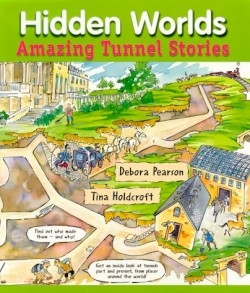Hidden Worlds
Amazing Tunnel Stories, Hidden! Series
Anyone who has marveled at humans’ ability to bore through mountains or build a network of subways and roads under cities and rivers, or even service areas under theme parks, will enjoy digging into some of the more amazing tunnels in history.
The author, a children’s writer, past editor of OWL: The Discovery Magazine for Kids, and former children’s librarian for the Toronto Public Library, also gives the animal kingdom credit for its tunnel-making with a chapter on moles. Her research has unearthed information that goes back to construction and use of tunnels in Egyptian pyramids, for attacking an English castle, for burial grounds under the streets of Paris, for mail in Prague, for tiny trains under Chicago, for Roman aqueducts, for escape from German prison camps, and for salt mining in Poland.
Pearson also tells about the fifth duke of Portland, an elusive Englishman who had tunnels dug under his estate so that he could avoid being seen in public. His tunnel system not only had passageways, but also elaborate underground rooms, including a ballroom. The duke could get from his house to his stables through his tunnel system, ride underground in a carriage to the railway station, and then have the entire carriage loaded on the train with him inside it.
The tiny train system that ran under the city of Chicago about ninety years ago was an inventive way to bypass the traffic congestion of the times. Locomotives so small that they held only the motorman pulled tiny cars that carried visitors, mail, freight, coal, and even garbage between buildings. About as “wide as a bathtub, they look(ed) like something you’d find at an amusement park, the kind of train you might like to ride on just for fun.” The trains stopped running when the company ran out of money.
What makes the “amazing stories” even more enjoyable are the illustrator’s clever, cartoon-like illustrations that show the tunnels and the activity in them and above ground. Holdcroft has more than thirty children’s books and seventy books for adults to her artistic credit.
The book includes additional information about tunnels, an index, and a note explaining the extensive research. There is also a warning that kids should never dig their own tunnels. Even if youngsters don’t grab a shovel, they should be tempted to further study “the hole story,” and have a new appreciation of the uses of tunnels through the ages.
Reviewed by
Linda Salisbury
Disclosure: This article is not an endorsement, but a review. The publisher of this book provided free copies of the book to have their book reviewed by a professional reviewer. No fee was paid by the publisher for this review. Foreword Reviews only recommends books that we love. Foreword Magazine, Inc. is disclosing this in accordance with the Federal Trade Commission’s 16 CFR, Part 255.

